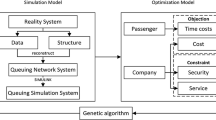Abstract
This paper provides a mathematical model for Three Gorges-Gezhou dam co-scheduling problem, based on full analysis of Three Gorges-Gezhou dam’s actual needs, to maximize the total throughput of Three Gorges-Gezhou dam and the utilization ratio of shiplock area and minimize the total navigation shiplock waiting time under multiple constraints. This paper proposes a series queuing network (SQN) scheduling algorithm to divide the total ships that intend to pass through the shiplocks into four queues and calculate dynamically the weight of priority for each ship. The SQN scheduling algorithm schedules ships according to their priority weights which is determined by the characteristics of each ship, such as length, width, affiliation, waiting time, and so on. In the process, the operation conditions of Gezhou dam related to the navigable shiplocks and the task balancing among different shiplocks also should be considered. The SQN algorithm schedules ships circularly and optimizes the results step by step. Real operation data from our project shows that our SQN scheduling algorithm outperforms the traditional manual scheduling in which the less computational time is taken, the area utilization ratio of the five shiplocks is increased, the waiting time of high-prioritized ships is shorten, and a better balanced and alternating run-mode is provided for the three shiplocks in the Gezhou dam.
Similar content being viewed by others
References
W. Zhang, P. Liao, and L. L. Wu, et al., Main parameters of water way lock capacity, J. of Traffic and Transportation Engineering, 2004, 4(3): 108–110.
J. N. Du and S. M. Yu, Dynamic programming model and algorithm of shiplock scheduling problem, Computer and Digital Engineering, 2003, 31(3): 47–50.
F. Y. Lu, H. Qi, and J. Cao, The computer application and research of permanent shiplock navigation lock chamber scheduling arrangement, Application Research of Computers, 2000, 17(6): 65–67.
Y. F. Liu and H. Qi, Application of DFS algorithm in the arranging of three-gorges permanent lock chamber, Computer Engineering, 2002, 28(8): 224–226.
Y. F. Liu and H. Qi, The two-dimension optimization arranging heuristic algorithm and its application in the Yangtse Gorges permanent shiplock decision system, Computer and Modernization, 2002, 18(1): 1–3.
W. Lai and H. Qi, The MADM of Three Gorges ship gates running, Control and Decision, 2002, 17(2): 163–166.
R. T. Zhang and X. M. Zhu, Fuzzy control of arrivals to two queues in series, Acta Automatica Sinica, 2000, 26(2): 192–198.
R. G. Ma and Y. N. Liu, Weight value determination method of high way construction comprehensive evaluation, Journal of Traffic and Transportation Engineering, 2005, 5(2): 110–112.
Author information
Authors and Affiliations
Corresponding author
Additional information
This work is supported by the National Natural Science Foundation of China under Grant No. 60904074, and the Natural Science Foundation of Hubei Province of China under Grant No. 2008CDB012, and the Specialized Research Fund for the Doctoral Program of Higher Education of China under Grant No. 200804871150.
Rights and permissions
About this article
Cite this article
Wang, X., Qi, H., Xiao, H. et al. Series queuing network scheduling approach to co-scheduling model of three Gorges-Gezhou dam. J Syst Sci Complex 23, 715–726 (2010). https://doi.org/10.1007/s11424-010-7195-9
Received:
Revised:
Published:
Issue Date:
DOI: https://doi.org/10.1007/s11424-010-7195-9




